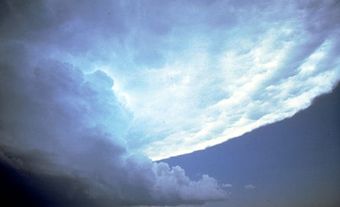Hail
Hail, precipitation consisting of lumps of ICE, about 5 mm to 10 cm in diameter and about 0.1 g to 1 kg in weight. A 290 g hailstone that fell near Cedoux, Sask, is one of the largest recorded in Canada. The authenticated world record belongs to a 770 g hailstone that fell in Coffeyville, Kansas. Small hailstones tend to be conical in shape, while larger ones are spherical. The very largest hailstones are oval and their surface is often covered with icy protrusions, which give the mistaken impression of several hailstones frozen together. In fact, large-surface lobes are produced like icicles, as a rapidly rotating hailstone spins off unfrozen water.
Formation
A hailstone begins as a frozen RAIN drop or a snow pellet growing in one of the smaller updraft cells (feeder clouds) adjacent to the main updraft of the hailstorm. Its development into a hailstone occurs in the powerful main updraft that lies at the core of a towering cumulonimbus CLOUD with a temperature near its top of -40° C. Once in the main updraft, the embryo hailstone is swept upward by the airflow faster than it can fall, ascending to heights as great as 15 km. As it does, it collides with and collects supercooled (below 0° C but unfrozen) cloud droplets, some of which freeze on its surface. Any impinging liquid water that does not freeze on its surface is shed into the hailstone's wake in the form of millimetre-sized raindrops, which may in turn freeze, creating more hailstone embryos. Vertical air currents of 10-50 m/s help keep the hailstone in the cloud for up to half an hour as it grows. Finally exiting the updraft, although not the cloud, it plunges back to the ground at speeds of up to 50 m/s.
The ice in a hailstone may be bubbly or clear, depending on the cloud's liquid-water concentration, the air temperature and the hailstone's size. Small hailstones, low temperatures and low liquid concentrations lead to bubbly, opaque ice (called rime ice), with small ice crystals and low density. The bubbles are the result of air trapped between individually frozen cloud droplets, making the ice porous. Conversely, large hailstones growing at temperatures near 0° C in high concentrations of liquid water tend to produce clear, solid ice with few bubbles. Under intermediate conditions, spongy ice forms. This is a matrix of ice containing up to about 50% unfrozen liquid water, which appears milky. Unless this liquid water freezes at a later time, spongy hailstones can be quite soft and slushy when they hit the ground. Soft hail can also be produced by porous rime growth followed by soaking with liquid water.
Variations of cloud temperature and liquid water content encountered by the hailstone during its growth lead to alternating layers of clear and bubbly ice which are onionlike in appearance. Although popular belief suggests that one layer is produced for each up-and-down trip made by the hailstone in the cloud, there is no evidence that even the largest hailstones ascend and descend more than twice, once as an embryo in a feeder cloud, and then again as a hailstone in the main updraft. Like fingerprints, the layers of a hailstone are clues to its unique history. Layers can be seen by examining a thin slice between crossed, polarizing filters.
Hailstorms
Although hail occurs in all provinces, it is most frequent and severe in Saskatchewan and Alberta, where some farms have been hit up to 10 times in one year, and others have experienced some hail damage in 6 years out of 8. Central Alberta experiences an average of about 56 hail days per year, the most severe storms occurring in July and August. Here, hail comes mostly from late-afternoon or evening THUNDERSTORMS, which can grow to heights of more than 15 km.
Severe hailstorms may last for several hours and leave a hailswath many kilometres wide and hundreds of kilometres long. The hailfall duration at a point, however, is typically less than 5 min, and the hail is often accompanied by heavy rain. Large hailstones (walnut-size) damage crops, buildings and automobiles. Giant hailstones (golfball size or larger) falling at high speeds have as much energy as a bullet and can injure or kill animals and people. A hailstorm that crossed Calgary on 28 July 1981 caused $150 million of damage to property. Ten years later on 7 September 1991, another storm led to insurance claims exceeding $400 million. The storm that produced the Edmonton TORNADO on 31 July 1987 was also a hailstorm, leaving behind $250 million in losses and a hail-damaged area around the city of 270 km2. Crops are also damaged or destroyed by hail: the total agricultural loss by hail in Canada is estimated at close to $200 million per year, with 85% of the losses attributable to only 12% of the storms.
Hail Suppression
In Alberta, attempts to reduce hail damage through cloud seeding with silver iodide have been undertaken since 1956. Despite claims that this practice is beneficial, carefully designed hail suppression experiments undertaken in Canada, Switzerland, the US and elsewhere have concluded that the hail from seeded storms cannot be distinguished from the hail from unseeded storms. In addition, the physical evidence about the chain of events that follows silver iodide seeding in hail clouds is incomplete. Aircraft measurements demonstrate that seeding with silver iodide can substantially increase the concentration of ice crystals in a supercooled cloud. Some scientists have hypothesized that these ice crystals accelerate the development of rain and thereby inhibit the growth of hail. More frequently, it is suggested that these additional ice crystals produce greater numbers of hailstone embryos. If this hypothesis is correct, silver iodide seeding in those cloud regions where there is an abundance of supercooled water could be dangerous, leading to more hailstone embryos, all of which are able to grow to a large size. Thus seeding hailstorms with silver iodide remains a controversial activity.

 Share on Facebook
Share on Facebook Share on X
Share on X Share by Email
Share by Email Share on Google Classroom
Share on Google Classroom


